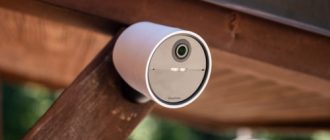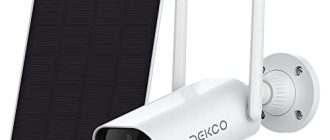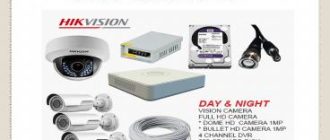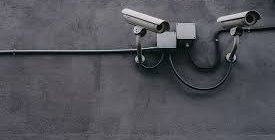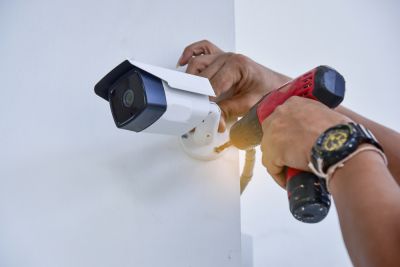
The Best Places To Install Home Security Cameras
Installing security cameras in your home is one of the best ways to ensure the safety and security of your family and belongings. With advances in technology, home security cameras have become more accessible and affordable than ever before.
When it comes to deciding where to install your home security cameras, there are several important factors to consider. The key is to strategically place your cameras in areas that provide the best coverage and surveillance.
First and foremost, it is crucial to install cameras at all entry points of your home. This includes front and back doors, as well as any windows that can be easily accessed. These areas are more vulnerable to break-ins, and having cameras in place will act as a deterrent for potential intruders.
In addition to entry points, it is also important to install cameras in high-traffic areas of your home. This could include the living room, kitchen, or hallway. By placing cameras in these areas, you’ll have a clear view of anyone who enters your home and can monitor their activities.
Another important consideration is to install cameras outside your home. This can include the front yard, backyard, and garage. Outdoor cameras are essential for capturing footage of any suspicious activity or potential threats on your property. They can also help to identify trespassers and monitor the overall security of your home.
Overall, the best places to install home security cameras are those that provide comprehensive coverage of your property and offer a clear view of any potential threats. By strategically placing cameras in these areas, you’ll have greater peace of mind knowing that your home is protected.
The Best Places To Install Home Security Cameras
When it comes to ensuring the safety and security of your home, installing security cameras is an important step. But where should you place them? Here are some of the best places to install home security cameras.
| Front Door | The front door is a common entry point for burglars. Installing a camera here allows you to monitor who comes and goes from your home. |
| Back Door | Similar to the front door, the back door is another vulnerable entry point. A camera here can help deter criminals and provide evidence if a break-in occurs. |
| Garage | The garage often contains valuable items such as vehicles and tools. Placing a camera in the garage can help prevent theft and provide video evidence if something goes wrong. |
| Driveway | A camera overlooking the driveway can capture any suspicious activity or vehicles entering your property. It provides an extra layer of security and can help identify potential threats. |
| Backyard | Many homes have backyard entrances or windows that can be targets for burglars. Installing cameras in the backyard can help monitor activity and prevent unauthorized access. |
| Living Room | While it may not be the first place you think of, installing a camera in the living room can provide a comprehensive view of your home. It can capture any suspicious activity or break-ins that occur inside the house. |
| Stairways | Stairways can be a vulnerable area, especially if your home has multiple levels. Installing cameras near stairways can help monitor movement and provide visual evidence of any incidents. |
| Basement | If your home has a basement, it’s important to secure this area as well. A camera in the basement can help prevent theft or damage to valuable items stored there. |
Remember, the best places to install home security cameras depend on the layout and specific needs of your home. Consider consulting with a professional to ensure optimal camera placement and coverage.
Front Door
The front door is one of the most important places to install a security camera in your home. It is the main entry point and a common target for burglars. By placing a camera at the front door, you will have a clear view of anyone entering or leaving your home. This can help you identify potential intruders and provide evidence in case of a break-in.
When installing a security camera at the front door, there are a few key considerations to keep in mind. First, make sure the camera is positioned at a height that provides a clear view of the area. It should be angled in a way that captures the faces of people approaching the door.
In addition, you may want to consider using a camera with motion detection capabilities. This will allow the camera to automatically start recording when it detects movement near the front door. This feature can be especially useful if you are away from home and want to be alerted to any suspicious activity.
Lastly, it is important to choose a camera that is weatherproof and durable. The front door is exposed to the elements, so the camera should be able to withstand rain, snow, and extreme temperatures. Look for a camera that is specifically designed for outdoor use.
Overall, installing a security camera at the front door is a smart choice for any home. It provides a visible deterrent to potential intruders and enables you to monitor who comes and goes from your property. By following these tips, you can ensure that your front door camera is positioned for optimal security.
Backyard
The backyard is one of the best places to install home security cameras. It is commonly overlooked as a potential area to monitor, but it is actually an important part of your overall security setup. By placing cameras in your backyard, you can keep an eye on the entire perimeter of your property and deter potential threats.
When installing security cameras in your backyard, consider placing them in strategic locations. These could include near entry points, such as back doors or patio doors. You may also want to consider positioning cameras to cover high-value objects like grills, outdoor furniture, or children’s play areas.
An important factor to keep in mind when installing backyard security cameras is weather resistance. Make sure the cameras you choose are designed to withstand the elements and have the necessary IP rating for outdoor use. A good installation tip is to mount the cameras high enough so that they are out of reach, but still provide a clear view of the area.
In addition to general surveillance, you may also want to consider specific types of cameras for your backyard, such as motion-activated cameras or night vision cameras. Motion-activated cameras will only record when motion is detected, saving storage space and making it easier to review footage. Night vision cameras will provide clear video even in low light or no light conditions.
- Place cameras near entry points
- Cover high-value objects
- Ensure weather resistance
- Mount cameras high enough
- Consider motion-activated or night vision cameras
By following these tips and suggestions, you can ensure that your backyard is properly monitored and enhance the overall security of your home.
Garage
The garage is an important area to consider when installing security cameras. It is often a target for burglars due to the valuable items and vehicles typically stored inside.
The best places to install security cameras in the garage include:
- Near the entrance: Position a camera near the garage door to capture any activity happening outside or inside the garage.
- Overhead view: Mount a camera on the ceiling or wall to provide a wide-angle view of the entire garage space.
- Intruder detection: Install cameras near windows or other access points to detect any potential break-ins or unauthorized entry.
- Vehicle monitoring: Set up cameras to monitor vehicles parked inside the garage for added security.
By strategically placing security cameras in the garage, homeowners can enhance the overall security of their property and deter potential intruders.
Driveway
The driveway is one of the best places to install home security cameras. It is the entry point to your property and an area where potential intruders can be identified. By placing cameras in strategic locations, you can monitor who is coming and going from your property.
When installing security cameras in the driveway, it is important to consider a few key factors. Firstly, you should position the cameras at a height that captures a clear view of the driveway. This may involve mounting the cameras on the walls of your house or on poles specifically designed for this purpose.
In addition to height, you should also consider the angle of the cameras. Position them facing both the entry and exit points of the driveway to capture footage of vehicles entering and leaving your property. This will provide you with a comprehensive view of any activity happening in your driveway.
To ensure maximum security, it is advisable to use cameras with motion detection capabilities. This feature will enable the cameras to start recording as soon as any movement is detected in the driveway. It will also alert you in real time, allowing you to take immediate action if suspicious activity is detected.
Finally, make sure to choose security cameras that are weatherproof and durable. The driveway is exposed to various weather conditions throughout the year, so it is important to invest in cameras that can withstand rain, snow, and extreme temperatures.
Overall, the driveway is a critical area to install home security cameras. By strategically placing cameras at the right height and angle, and choosing cameras with motion detection and weatherproof features, you can effectively monitor and protect your property.
Staircase
The staircase is one of the key places to install home security cameras. It serves as a central point of movement and can provide valuable surveillance coverage for your home’s entrances and exits. Installing a security camera on or near the staircase allows you to monitor all activity on the stairs, ensuring that you have a clear view of anyone coming or going.
When installing a security camera on the staircase, consider placing it in a location that offers optimal coverage. The top or bottom of the stairs are popular spots, as they provide a wide field of view. You may also consider placing a camera halfway up or down the staircase to capture both upper and lower levels.
Ensure that the camera is securely mounted to prevent tampering or theft. A strong and stable mounting bracket is essential to keep the camera in place, even as people move around the stairs. Additionally, consider using a camera with night vision capabilities to ensure visibility in low-light conditions.
Keep in mind that privacy concerns may come into play when positioning cameras on the staircase. Be sure to respect the privacy of individuals using the stairs and avoid placing cameras in areas where they may intrude upon personal space, such as bedrooms or bathrooms.
By strategically placing security cameras on or near the staircase, you can enhance the overall security of your home and have a better understanding of who enters or exits your property. Take the time to evaluate the layout of your staircase and determine the best locations for camera installation to ensure maximum coverage and protection.
Living Room
The living room is one of the most important places in a home to install security cameras. It is where families spend a significant amount of time and also where valuable belongings, such as electronics and artwork, are often found.
To ensure the best coverage, it is recommended to install cameras in the corners of the room. This allows for a wide-angle view, capturing the entire space. Cameras can be mounted on the walls or placed on shelves, depending on personal preference.
When positioning the cameras, it is important to consider any potential blind spots. Make sure that there are no obstructions, such as furniture or curtains, blocking the camera’s view. Additionally, it is a good idea to angle the camera slightly downward to capture any suspicious activity near the entrance or windows.
In terms of camera type, a fixed camera would be suitable for a living room. These cameras provide a steady, reliable view and can be easily connected to a home security system. It is also recommended to choose cameras with high-resolution capabilities to ensure clear footage.
To enhance security in the living room, it is advisable to install a security camera with night vision. This allows for monitoring even in low-light conditions, providing peace of mind during the nighttime hours.
In conclusion, installing security cameras in the living room is essential for comprehensive home security. By strategically placing cameras and selecting the appropriate type for the space, homeowners can ensure optimal surveillance and protect their valuable belongings.
Kitchen
The kitchen is one of the best places to install home security cameras. It is a high-traffic area where a lot of activity takes place, making it important to have surveillance in this space. By having cameras in the kitchen, you can monitor who enters and exits the area, keeping an eye on any potential intruders. Additionally, having cameras in the kitchen can help keep an eye on your family members and pets as they go about their daily activities in the heart of your home.
Some suggested places to install cameras in the kitchen include near entrances, where you can capture a clear view of anyone entering or leaving the area. Another good spot is above the stove or sink, as these areas are often focal points where people spend a lot of time. Placing cameras at these points can help you keep track of what is happening while you are away or occupied with other tasks.
When installing cameras in the kitchen, it is important to make sure they are positioned discreetly and securely. This can be achieved by using small, inconspicuous cameras and mounting them in high corners or on the ceiling. By doing this, you can maintain the security of your home without compromising the aesthetics of your kitchen.
Overall, installing security cameras in the kitchen is a smart choice to ensure the safety of your home and loved ones. With strategic placement, you can have peace of mind knowing that this vital area of your home is under surveillance.
Bedroom
The bedroom is one of the most important places to install home security cameras. This is where we spend a lot of our time, and it is also where we keep our most personal belongings. By installing a camera in the bedroom, you can monitor any suspicious activity and keep an eye on your property and loved ones.
When choosing the best place to install a camera in the bedroom, consider placing it near the entrance or facing the bed. This will give you a clear view of anyone entering the room or approaching the bed. Another option is to mount the camera on a wall or ceiling to get a wider field of view. Remember to keep the camera discreet to prevent it from being easily noticed or tampered with.
If you have a dresser or nightstand near the bed, you can also consider installing a hidden camera. This will provide additional security without being easily detectable. It’s important to check the regulations and laws regarding hidden cameras in your area to ensure you are following the legal guidelines.
When installing a camera in the bedroom, make sure to position it at a height that captures the entire room and minimizes blind spots. Test the camera’s angle and adjust accordingly to achieve optimal coverage. Additionally, check the camera’s resolution to ensure clear and detailed footage.
Remember to regularly check and maintain your home security cameras to ensure they are functioning properly. This includes cleaning the lens, adjusting the positioning if needed, and checking for any signs of damage or tampering.
Overall, placing a security camera in the bedroom is an essential step in protecting your home and loved ones. By choosing strategic locations and maintaining the cameras regularly, you can enhance the overall security of your property.
Basement
When it comes to home security, the basement is an important area to consider. While it may not be the most glamorous part of the house, it is a common entry point for burglars. Installing security cameras in the basement can provide you with an extra layer of protection.
The best place to install security cameras in the basement is near the entry points, such as windows and doors. You should also consider placing cameras near valuable items, such as safes or storage areas. This will help to deter potential intruders and provide evidence in case of a break-in.
In addition to entry points, you should also install security cameras in areas with limited visibility, such as dark corners or stairwells. This will ensure that you have a clear view of any suspicious activity that may occur in these areas.
When installing security cameras in the basement, it is important to make sure they are properly positioned and angled. You should test the cameras before fully installing them to ensure they have a clear view and are capturing the intended areas.
Furthermore, it is recommended to choose security cameras that are specifically designed for outdoor use, as basements can be prone to moisture and temperature fluctuations. Waterproof and weather-resistant cameras will ensure that they continue to function properly regardless of the environment.
Remember, the goal of installing security cameras in the basement is to deter criminals and provide you with peace of mind. By strategically placing cameras in key areas, you can enhance the security of your home and protect your belongings.
In conclusion, the basement is an important area to consider when it comes to home security. By installing security cameras near entry points, valuable items, and areas with limited visibility, you can greatly enhance the overall security of your home.
Patio
The patio is one of the best places to install home security cameras. It is an outdoor space that provides easy access to the exterior of your home, making it an ideal location for surveillance. Additionally, placing cameras on the patio can help monitor entrances and deter potential intruders.
When positioning security cameras on your patio, consider placing them in strategic areas such as near doors, windows, and other entry points. This will ensure maximum coverage and protection for your home.
Furthermore, installing cameras on the patio allows you to keep an eye on your outdoor areas such as gardens, swimming pools, and driveways. This helps to ensure the safety of your property and belongings.
It is important to choose high-quality cameras with features such as night vision, motion detection, and remote viewing to enhance the security of your patio. Additionally, consider weatherproof cameras that can withstand various outdoor conditions.
Remember to position the cameras in a way that does not invade your neighbors’ privacy. It is also a good idea to inform your neighbors about your security cameras to maintain good relationships and create a sense of community security.
| Monitor entrances | Choose high-quality cameras |
| Deter potential intruders | Position cameras strategically |
| Keep an eye on outdoor areas | Consider weatherproof cameras |
| Enhance property safety | Respect neighbors’ privacy |
Pool Area
The pool area is an important place to consider when it comes to home security. Installing security cameras near the pool can help ensure the safety of family members and guests, as well as protect against unauthorized access.
There are several key places to install cameras in the pool area. One great location is near the entrance or gate to the pool. This can deter potential intruders and provide a clear view of anyone entering or leaving the area. Additionally, installing cameras around the area’s perimeter can help monitor for any suspicious activity.
It’s also crucial to have cameras positioned to capture activity in and around the pool itself. These cameras should be placed at a high angle to provide a wide and clear view without any blind spots. This allows for a comprehensive view of the pool area and can help prevent accidents or monitor any emergencies that may occur.
When installing cameras in the pool area, it’s important to consider any local regulations or guidelines that may be in place. Some areas may have restrictions on camera placement or require permission from homeowners’ associations.
In conclusion, the pool area is one of the best places to install home security cameras. By strategically placing cameras near the entrance, around the perimeter, and overlooking the pool itself, you can ensure the safety and security of your pool area and the people using it.
Side Entrance
When it comes to home security, the side entrance is often overlooked. However, it is an important area to consider installing security cameras.
Side entrances are often hidden from view, making them an ideal target for potential intruders. By installing cameras in this area, you can deter criminals and keep your home and family safe.
Choose security cameras that have a wide viewing angle to cover the entire side entrance. Position them at strategic points to capture any suspicious activity. Motion-activated cameras are also a great option, as they will start recording as soon as movement is detected.
Make sure to install the cameras high enough to prevent them from being tampered with or obstructed. Also, consider using security camera housings to protect them from the elements.
In addition to preventing break-ins, having cameras at the side entrance can also help you monitor deliveries and see who is approaching your home. This added level of security will give you peace of mind and provide valuable evidence in case of any suspicious incidents.
Don’t neglect the side entrance when thinking about home security. Install cameras in this area to keep your home safe from all angles.
Home Office
When it comes to ensuring the security of your home office, it’s essential to install security cameras in strategic places. Here are some of the best spots to install these cameras:
- Main entrance: Placing a camera at the main entrance of your home office will give you a clear view of anyone entering or exiting the space.
- Windows: Installing cameras near windows provides an excellent vantage point to capture any suspicious activity or potential break-ins.
- Workspace area: Positioning a camera in your workspace area allows you to monitor your desk, important documents, and valuable equipment.
- Safe or storage room: If you have a safe or a storage room where you keep valuable items, placing a camera in this area can help prevent theft or unauthorized access.
- Equipment room: If you have a dedicated room for your office equipment such as servers or routers, consider installing a camera to monitor this area and detect any unusual activity.
Remember to position the cameras at a height and angle that offers a clear view without any obstructions. Also, placing visible cameras can act as a deterrent, making potential intruders think twice before targeting your home office.
By strategically installing security cameras in your home office, you can enhance the overall security and peace of mind for your workspace.
Garden
The garden is often considered to be one of the best places to install home security cameras. By placing cameras strategically in the garden, you can have a full view of the exterior of your home and monitor any suspicious activity.
When deciding where to install the cameras in your garden, it is important to consider the following tips:
- Entrance points: Install cameras near the entrance points to your garden, such as gates or doors, to capture any activity when someone enters or exits.
- Driveway: If you have a driveway, consider installing a camera to monitor any vehicles that enter or park in that area.
- Perimeter: Place cameras along the perimeter of your garden to have a clear view of the entire area. This can help deter potential intruders and provide evidence in case of any incidents.
- Backyard: If you have a backyard, make sure to install cameras to monitor this area as well. Backyards are often targets for burglars as they are secluded and can provide easy access to the rest of the house.
- Outdoor valuables: If you have outdoor valuables, such as a shed or expensive outdoor equipment, installing cameras nearby can help protect them from theft.
In addition to the placement of cameras, it is essential to ensure proper camera installation. Make sure the cameras are securely mounted and positioned to capture the desired angles. Regularly check and maintain the cameras to ensure they are functioning properly.
Remember that the cameras should always be used in compliance with local laws and regulations regarding privacy. Consider informing your neighbors about the presence of security cameras to maintain good relationships and avoid any misunderstandings.
Q&A:
Where should I install home security cameras?
When installing home security cameras, it is important to place them in strategic locations that provide maximum coverage. Some of the best places to install home security cameras include the front and back doors, garage, driveway, and windows.
Should I install security cameras inside or outside my house?
For comprehensive home security, it is recommended to install security cameras both inside and outside your house. Exterior cameras can deter potential intruders, while interior cameras can help monitor the activity inside your home.
Are there any specific features I should look for in home security cameras?
When choosing home security cameras, look for features such as high-resolution image quality, night vision capabilities, wide-angle lenses, motion detection, and remote viewing options. These features can enhance the effectiveness of your home security system.
What are some common mistakes to avoid when installing home security cameras?
Some common mistakes to avoid when installing home security cameras include placing them at the wrong angle, installing them too high or low, not securing them properly, and not considering the lighting conditions of the area. It is important to carefully plan the installation to ensure maximum effectiveness.
Can I install home security cameras by myself, or do I need professional help?
While it is possible to install home security cameras by yourself, professional help is often recommended. Professionals can provide expertise and ensure that the cameras are installed correctly and optimally positioned for maximum coverage. They can also help with the setup and configuration of the camera system.


